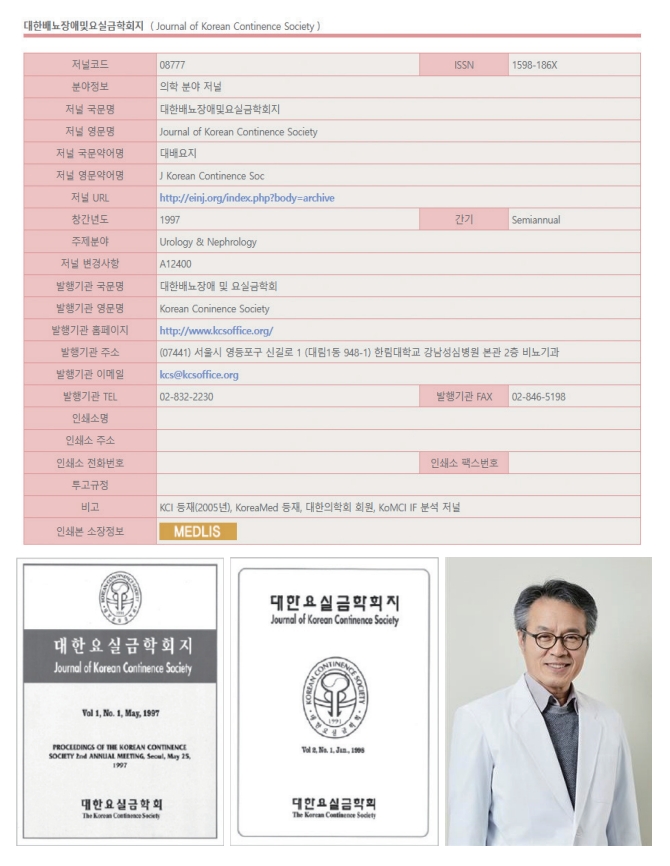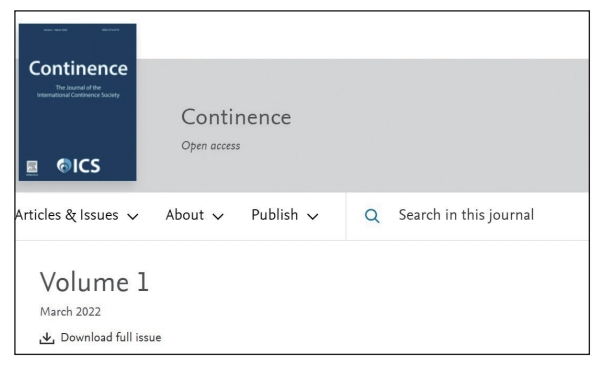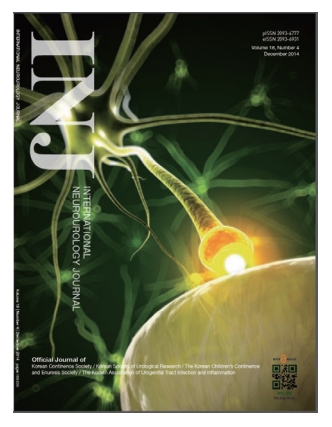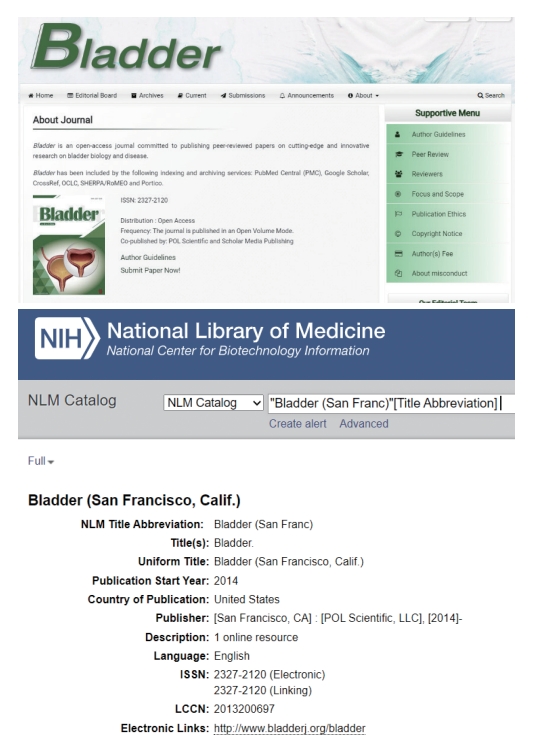INTRODUCTION OF THE EDITORIAL BOARD
As of 2022, the editorial board of the Korean Continence Society is in charge of publishing International Neurourology Journal (INJ), an official journal of the Korean Continence Society (KCS).
The editorial board is in charge of selecting papers submitted to INJ through peer review and publishing the journal. In addition to publication, through mutual exchange with outstanding researchers at home and abroad, the editorial board has played a role in introducing cutting-edge academic research results in the form of speaker invitations to members of the KCS, researchers, and clinicians who read INJ [1].
Thanks to the efforts of the members of the KCS and its editorial board since the official conversion of the journal to the publication of English-only papers in April 2010 (Vol. 14, No. 1), the journal was indexed in Science Citation Index Expanded (SCIE) on July 15, 2014. Currently, the editorial board is led by Professor Khae Hawn Kim (Chungnam National University) with 2 secretaries, 21 editors, and 1 manuscript editor.
Thanks to the ongoing dedication and efforts of the editorial committee, the full support of the KCS, and the many high-quality papers discovered through the submission and publication process, INJ, which started with an impact factor (IF, citation index) of 1.015 in 2014, when it was included in SCIE, had an IF of 3.038 in 2021 and is now preparing to take another large leap forward.
TRENDS IN THE EDITORIAL BOARD
The KCS published the first issue of its official academic journal (1598-186X, semiannual) on May 30, 1997.
On February 1, 1999, when the then editor-in-chief Jeong Gu Lee (Korea University) applied for the co-authorship required for the urology specialist examination, he revised the name of the journal to Journal of Korean Continence Society and achieved the co-authorship required for the examination on September 1, 2001 (Fig. 1).
From January 2000 to 2002, Professor Dong Hwan Lee of Catholic University again served as the editor-in-chief and revised the cover of the journal starting in the June 2000 issue (Fig. 2).
Professor Choal Hee Park at Keimyung University was appointed as the editor-in-chief in 2002 (Fig. 3). He carried out the second cover revision and had the journal listed in KoreaMed (an abstract database designed to facilitate the online search of English bibliographic information and English abstract information of medical journals issued by the Korean Association of Medical Journal Editors) on June 30, 2003.
In 2004, Professor Hyung Jee Kim of Dankook University was appointed as the editor-in-chief (Fig. 4). The next year, on January 17, 2005, the journal was indexed in the Korean Citation Index. On May 31, 2005, Continence, as an English-language journal, was published as an annual for 1 year only. Later, Continence became the title of the journal of the International Continence Society, starting with volume 1 in March 2022 (Fig. 5). Lori Birder, the editor-in-chief of the journal, is a neuroscientist who served as the deputy editor-in-chief of INJ from 2018 to 2022. On a side note, Continence (ISSN: 1738-6268/Publisher: Korean Continence Society), which was registered by the Korean Continence Society in 2005 (Fig. 6), has not been discontinued, but it is no longer published. In general, a preexisting journal name can be used by other societies or institutions. However, there is a stipulation: even if there is another existing journal with the same title, the 2 journals have different ISSNs, and the name of the region or country is generally presented along with the journal title. As shown in the figure below, it is possible to use a subtitle for journals with the same title (Fig. 7).
As an editor, I regret that the editorial board did not strongly focus on internationalization and thus failed to get a head start in global innovation. Looking back on the history of the Korean Urological Association, I believe that the importance of the practical international cooperation of journals cannot be overstated. It is necessary to reflect on when and how the innovative international collaboration of the hard-working nurses who had been dispatched to Germany from South Korea, which was underdeveloped at the time, led to the internationalization of nursing journals.
Five years later, on June 1, 2009, the Journal of Korean Continence Society was registered with National Research Foundation of Korea as a semiannual.
In March 2010, Professor Tack Lee started innovative changes as an editor-in-chief (Fig. 8).
In April 2010, the Journal of Korean Continence Society was renamed International Neurourology Journal, the cover was changed, and a new start was made as an international journal by publishing English-only papers (Fig. 9).
After the journal was indexed in SCIE in 2014, the editorial board continued to make efforts to publish high-quality papers for readers and, at the same time, took the lead in changing the website of the society and the cover of the journal.
In order to present on the cover the idea that basic research is an important area of interest in the field of neurourology, the editorial board and LG Ads held various discussions and consultations and selected the current cover design, which has been used since 2015 for volume 19 No. 1 (March issue). At the same time as the SCIE registration, an attempt was made to change the journal name to The Bladder, and the domain was purchased in advance, but this change was rejected based on the collected opinions of the KCS membership. In the same year, the name Bladder was adopted by a United States journal, which launched as Bladder (San Franc), as shown in the figure below in compliance with the abovementioned title stipulation (Fig. 10). As I witnessed, the former editors-in-chief struggled twice to make changes and innovations. Now that I think about it, I just admire them. What IŌĆÖm trying to say is, ŌĆ£we donŌĆÖt know what we have until we read it.ŌĆØ
YEAR 2015 ŌĆō PRESENT
A total of 800 copies of INJ had been printed and delivered to members annually, but in 2017, the print run was reduced to 300 copies and physical copies were sent only to essential places such as national/public libraries. Since 2018, only digital printing has been used.
In 2016, the Aims & Scope were revised to expand the academic fields encompassed by ŌĆ£neurourologyŌĆØ through the inclusion of various fields such as basic/biomedical engineering and artificial intelligence. In addition, many researchers from Korea and abroad who are neither members of the Korean Urological Association nor the Korean Continence Society, but have made outstanding academic achievements, have been recruited to serve on the editorial board, and these efforts are continuing.
In particular, thanks to the efforts of Professor Tack Lee, the first editor-in-chief, in September 2017, and the support of the KCS, 2 world-renowned scholars in the field of neurourology, Karl-Erik Andersson (professor emeritus at Wake Forest University School of Medicine, USA) and Lori Birder (professor emeritus at University of Pittsburgh School of Medicine, USA) were appointed as deputy editors-in-chief, which contributed to improving the international recognition of INJ and increasing the submission and publication of quality papers through personal networks. At the same time, as part of the editorial board renewal project, 3 ethics editors were selected and included in the editorial board to review and supplement the ethical aspects of research and papers, the importance of which is increasingly recognized. Since 2018, the submission of author contribution statements has been mandatory and ethical regulations have been strengthened.
In 2016, it was decided to publish supplements in addition to quarterly publications based on a strategic decision to enhance the citation index. The supplements have been selected through editorial board discussions to include outstanding papers on specific themes with a high likelihood of citations. Except for 2017 and 2018, when 1 and 3 supplements were published, respectively, these supplemental publications have been issued twice every year since 2016.
In 2015, XML work, which is essential for the operation of the journal website and publication, was transferred to M2PI (Seoul, Korea) for work efficiency and cost reduction. Since the publication of volume 18, No. 4 in 2014 (December issue), the ORCID codes of corresponding authors have been presented in papers of INJ to provide convenience to readers by integrating research results and linking research results with researchers. In April 2018, the journal received SSL certification as part of a project to strengthen the security of the INJ website and submission system.
In 2017, after benchmarking leading journals such as the New Engl J Med, the journal was reorganized to have 6 separate sections (Home/About/Article & Organ/Issues/Diseases & Topics/Author information). In addition, all of the papers published by INJ have been classified by disease and subject so that readers can search and view papers easily in an appropriate menu, thereby increasing the citations and accessibility of the papers. Furthermore, the main page of INJ was reorganized into 2 columns to improve readability, which was the first attempt to make a change of this type in South Korea.
Following the first editor-in-chief Tack Lee, who laid the groundwork for the current INJ in a multitude of aspects, in addition to the 2 great achievements of the first publication of INJ and its inclusion in SCIE while serving as the editor-in-chief for 10 years from the publication of volume 13 No. 2 in 2009, Professor Hong Sang Moon at Hanyang University was elected as the second editor-in-chief in July 2019 and served until June 2021 (Fig. 11).
During this period, new initiatives such as actively gathering video data and attracting publicity through the opening of the INJ-only YouTube channel, along with a detailed analysis of previously published papers by country, field, and paper type, were conducted to establish a strategy to improve the citation index. In addition, a memorandum of understanding (MOU) was signed with International Society for the Study of BPS (ESSIC) to make INJ an official journal of ESSIC, attract paper submissions from Europe, and improve peer review quality by securing foreign reviewers. As part of the MOU, Professor Wyndaele Jean Jacques (University Antwerp, Belgium), the chairman of ESSIC, was appointed as an associate editor of INJ. Thanks to these efforts, INJŌĆÖs citation index, which was stagnant at 1.794 in 2019, finally rose to above 2 (2.835) for the first time in 2020 [2]. Furthermore, to prepare for the future of INJ, its strengths and weaknesses have been analyzed since July 2021 by Professor Khae Hawn Kim, the editor-in-chief (Fig. 12).
In addition, Hwan Tae Ahn, the representative manuscript editor of JTS (Seoul, Korea), who has been making dedicated efforts for English publication and SCIE registration from 2010 to the present, is also a member of the editorial board and has made great contributions to INJŌĆÖs development and preparations for the future.
Although the citation index in 2022 is 3.038, a huge leap from that in 2014 when it was first indexed by SCIE, efforts are being made to take a further leap forward as the number of citations for clinical papers is relatively low compared to that for basic research papers. Despite efforts to expand the base of reviewers, there is still a long way to go, and relative to the reputation of the journal, foreign reviewers are lacking.
I started working as a member of the editorial board as an editorial secretary under editor-in-chief Tack Lee in 2010. Furthermore, following the editor-in-chief Hong Sang Moon, I have been serving as the editor-in-chief since June 2021 [2]. Therefore, I would like to express my humble opinions to all members of the Korean Urological Association.
As an editor, reading and evaluating othersŌĆÖ writing is always a difficult and anxiety-inducing task. Although we are placed in a situation where we have to evaluate researchers in various fields, each field has its own academic characteristics and culture, to the point that even the concept of excellent research is different, and limited articles can be published with reference only to the reviewersŌĆÖ specific opinions. Therefore, it seems very difficult to establish the priority of publication or to determine which articles are better. Is there a criterion that satisfies everyone and works across all fields? The issue of fairness is also crucial. I think that review and publication ethics are the lifeblood of academic journals. Since various journals are published in one field, competition and comparison between journals are inevitable. Although the IF is commonly used as an evaluation metric, I do not think that the IF can be an absolute evaluation criterion.
Nonetheless, according to the 2021 Journal Citation Report published by Clarivate, the 2021 IF of INJ, the official academic journal of our society, has finally entered the 3-point range with 3.038.
Although this IF is very low compared to those of famous academic journals in the United States and Europe, which have significantly higher IFs, I believe that many superb articles, including research in basic and clinical neurourology, have been published in INJ and have undoubtedly made major contributions to academic development. In the future, although citation of these articles is important, I think that striving to play a leading role in the introduction of good articles to researchers in neurourology is an essential value that INJ should continuously pursue.
Now is the time to pay attention to the social responsibility of academic journals beyond an evaluation based on research achievements and research results and capabilities. It is necessary to create an environment in which researchers can take on new challenges, thereby facilitating industry-university-research collaboration. In addition, academic journals have the responsibility to take steps to avoid discrimination among researchers and respect ethics. Efforts should be made to create a better research environment rather than relying upon the traditional evaluation criteria, and preparation should be made for broadening readersŌĆÖ options and providing new perspectives. The evaluation methods of journals will be diversified in the future to include a focus on social contributions. I believe that going beyond the role of knowledge provision and instead helping in the acquisition process so that readers can apply their knowledge directly to real situations will strengthen the foundation of our journal.
In the middle of summer, looking at four leading academic journalsŌĆ”





















